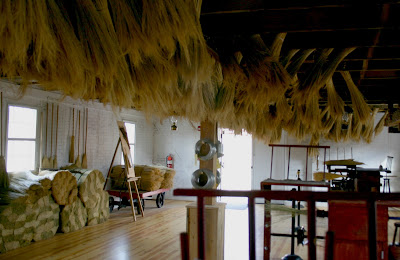Are you the spontaneous type or, when you travel, do you have a need to plan nearly every minute of your trip? Personally, I like to go with the flow, but during our years of traveling with children, I was forced to do more planning than comes naturally to me. Now that we're empty nesters, though, travel is more to my liking--a bit more free flowing.
On our recent trip to northern Colorado, my husband and I, on a whim, drove north an hour to Laramie, Wyoming. After a great lunch at a fun establishment across from the University of Wyoming campus, we spent an entire afternoon engrossed in the story of the Wyoming Territorial Prison.
The Wyoming Territorial Prison State Historical Site is exceptional, as is the self-guided tour, which features a small number of the male and female prisoners who were incarcerated at the prison during its 30 years of operation. Built in 1873, it continued to operate as a penitentiary until 1903.
Records indicate that about 1,000 men and 12 women were incarcerated here. Among the most famous outlaws was Butch Cassidy, who served 18 months for stealing horses. He was released early for good behavior. Apparently, the worst was yet to come.
This camera photographed Butch Cassidy.
Prisoners often were transported to the prison in a horse-drawn wagon. They began their prison stay in the processing room, where they were photographed (a sample of a prisoner number is on the chair) and given a uniform. As you can see, the prison stripes were real. And, wool for year-round wear!
Two separate wings, north and south, contained 42 cellblocks each, with 14 cells on each of three levels. The guards also had quarters in the prison structure, on the second level.
Over the years, male prisoners were employed in many types of endeavors including laundry, cutting ice from the nearby Laramie River to sell to local businesses, digging clay that was used in brick making and quarrying stone to be used as building material. They also did leather work, bread baking, candle making, shoe repair, taxidermy and some incredibly detailed and beautiful furniture carving. But, the rate of prisoner escape, much of which occurred during these activities, was a whopping 25 percent!
The prison was surrounded
by a 14-foot fence with guard towers
in the four corners.
Prisoners ate well, unless they were in solitary, they received medical and dental care on site when needed and the male inmates exercised during manual labor. Females prisoners were segregated from the males and, in general, were confined to their cell block, participating in only minor activities such as mending uniforms.
The prison kitchen
View of the back of the prison
from the window of the original kitchen.
On-site dental chair & equipment
After Wyoming became a state and the prison was closed, it was used as a stock farm and experimental station for the University of Wyoming for many years.
I hope you enjoyed this brief history and these photos, which give a small glimpse into life at the Wyoming Territorial Prison. The restoration of this facility is remarkable, the tour information is compelling to the point of being gripping. But, beyond that, I found the building itself and the prison artifacts to be a beautiful, if not somber, form of art in their own right. I'll leave you with the following photographs--small teasers of a couple of future posts also inspired by this remarkable historic site.
Linking to:

![]()




































